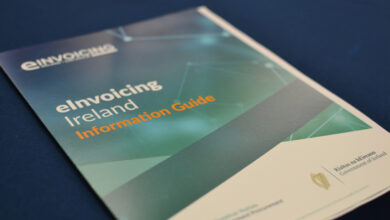Digital services: Supporting life events

Head of Digital Services in the Office of Government Chief Information Officer (OGCIO), Tony Shannon, discusses the evolution of a user-centric approach to public sector design and delivery, in an important decade.
In March 2022, the OGCIO, under the auspices of the renamed Department of Public Expenditure, NDP Delivery and Reform (DPENDPDR), published its decade-long vision to digitise public services in the form of Connecting Government 2030: A Digital and ICT Strategy for Ireland’s Public Service.
Much of the focus of that strategy, explains Shannon, is on the delivery of digitalised systems and services to support citizens through the delivery of more efficient ‘cradle to the grave’ services.
The Head of Digital Services believes that in a time when the public in Ireland is facing multiple crises ranging from the Covid-19 pandemic to housing, health, and refugee crises, now more than ever, the efficient delivery of public services is critical. However, he is also aware that the requirement of fundamental change to the organisational structure of public services in Ireland is a major challenge.
The Civil Service Renewal 2030 strategy, published in May 2021, set out the Government’s intention to deliver ‘digital first’ services, progress under which can already be seen through existing work by the OGCIO, such as the evolution of gov.ie, the information platform aimed at citizens, or the Build to Share applications – tools developed for civil servants delivering services.
Shannon explains that the pandemic, and the subsequent public service response, highlighted the ability of public services to not only roll out specific services, but also deliver them at a speed which has set an expectation benchmark for mobilisation.
“Building on these lessons we have learned in recent years, we are now trying to line up with governments around the world to address the effective delivery of digital public services for citizens’ life events, which are essentially the major moments of interaction between government and the people we serve,” says Shannon.
“In designing these services digitally, we are taking a user-centred design approach. Essentially, this is the public service catching up with the rest of industry in saying when you design a service, the first and central building block is the user.”
DPENDPDR is leading an initiative to support public service organisations to deliver user-centric services that are accessible, effective, and efficient in line with Actions 12, 13, and 14 of the Civil Service Renewal Action Plan 2024. The first phase of this initiative was to develop and launch Designing Our Public Services, the first prototype set of design principles for public services in Ireland.
“We are now in a position to talk about design principles, which line up with good international practice. These begin by putting the citizen at the centre of how we design our services, and not, as historically might have been the case, the organisational structure.”
Highlighting an iterative approach, rather than the traditional ‘waterfall’ approach to service design, Shannon says that OGCIO is building upon progress under Build to Share, where a service is built once and shared across the public sector.
“We are building on from that in terms of a much more open approach and embracing issues like open architecture, open APIs, open source and tacking to what is now known as the GovStack approach,” he explains.
GovStack is a thought-leading approach to designing and delivering public services internationally, led by the UN, whereby a set of building blocks can be re-used. Shannon outlines the seven building blocks which Ireland are trying to line up against as:
- Digital identity
- Content management
- Data collection – e forms
- Case management – eCase
- Messaging
- Credential-Wallet
- Information mediator
Setting out a move to steer the direction of gov.ie towards being more than an informational service for citizens, the first step will be citizen log in via MyGovID, the digital identity building block needed to ensure users are authenticated.
“We are now trying to line up with governments around the world to address the effective delivery of digital public service for citizens’ life events…”
Tony Shannon, Head of Digital Services, Office of Government Chief Information Officer
 Developed in conjunction with An Garda Síochána and the HSE, the e forms solution is the development of a generic forms tool which can be re-used for multiple purposes for capture of information in electronic form.
Developed in conjunction with An Garda Síochána and the HSE, the e forms solution is the development of a generic forms tool which can be re-used for multiple purposes for capture of information in electronic form.
The eCase solution is a case management software which allows the public servant to take a generic application and run a workflow around, for example, approving, assigning, or re-assigning a citizen’s application for services.
The digital post box, which is already operational and serving the needs of a variety of departments, allows for secure digital messaging between the government and the citizen. While a digital wallet is expected to be a ubiquitous tool that will allow for a safe store of all credentials issued by the Government.
Shannon highlights that most of this work is either already working in place, or, in the proof-of-concept stage, outlining his belief that the Government is on the cusp of important progress. However, he is equally aware that challenges exist.
“The most implicit challenge is that transformational changes to public services challenge the existing organisational structures, meaning that change will be disruptive and challenging for departments.
“At the same time, this is a tremendous opportunity to co-create the future that our citizens need and whereby the use dictates and informs the design of the services that will support them from the cradle to the grave.”
He concludes: “We are at a moment that matters. Currently, there is a gap, but we are moving towards supporting important events in peoples’ lives with digital services.”





